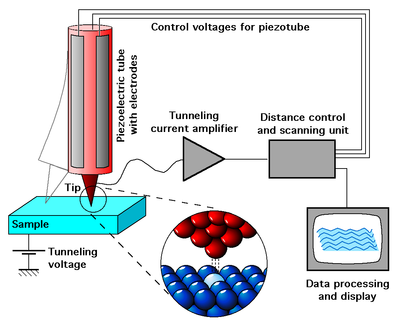The STM is an ingenious gadget, invented in 1981 at IBM Zurich. An atomically sharp probe is positioned above a sample; the gap is typically on the order of a nanometer. The probe and the sample are both electrically conductive. A voltage is applied between the probe and the sample. Electrons tunnel across the gap.

It turns out that the tunneling current is very strongly dependent upon the gap distance. So you build a servomechanism that moves the probe up and down in the Z direction, to keep the gap distance constant by keeping the tunneling current constant. Next, you scan the probe in the X and Y directions, tracking out a raster pattern like the one on your television screen. By looking at the Z position information from the servomechanism, you end up with a function Z = f(X, Y) and when you plot that function, or use it to color the pixels on a computer screen, you get pretty pictures of atoms.

The STM is so conceptually simple that it's possible to build one as a hobbyist.
A few years after the STM, the AFM or atomic force microscope was invented. With this device, the interaction between the probe (this time on the end of a cantilever) and sample is not an electric current flow. Instead it is a force due to the Van der Waals interaction. The force can be measured using piezoelectric strain gages built into the cantilever, or using a reflected laser beam to measure deflection of the cantilever.

You would have hoped that these microscopes would have been useful in pushing atoms around as well as seeing them. To a limited extent they are, but not so useful that you can start to build molecular machines with them. Darn.
1 comment:
Excellent. A very good article. Look forward to seeing more of them.
Post a Comment